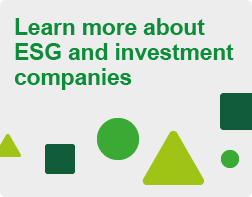ESG Policy
Overview
The Company does not have an explicit ESG Strategy, however as described in the Company's Annual Report, the Company is developing its approach to ESG. Elaborating, discussing and adopting a formal ESG Strategy will allow the Company to build a mutual understanding around the expectations of its stakeholders in relation to CEIBA’s ESG Strategy, which in turn should also have a positive effect on the Company’s financial sustainability.
In parallel with obtaining input regarding strategic goals from the Board, the Investment Manager, ESG specialists and other third parties, a detailed analysis will be carried out during the year of the Company and its assets. The principal goal is to present and table the formal ESG Strategy of CEIBA for approval during the present year so that the Board can present, explain and embed an ESG Strategy as one of the factors driving long-term value creation within CEIBA and influencing its performance against the strategic goals of the Company.
In short, the Board believes that by having a proper ESG Strategy in place, the Company will add a formal ESG framework as one of the drivers for long-term sustainable financial returns and adequately manage environmental, social, and governance factors as both risks and opportunities.
It is our intention that during the present year an in-depth analysis will be carried out on the general status of ESG factors within the Company, its subsidiaries and assets. Along with the above and the wider review of the ESG context in Cuba, this should enable the Company to highlight key ESG topics for focus. The Board also intends to verify whether it would be possible to periodically undertake existing assessments and methodologies to review ESG performance of the underlying assets and implement and monitor sustainability action plans. As a result, the Company will produce a draft ESG Policy
and Approach that will be presented for approval to the Company’s shareholders.
On Cuba - summary of country level ESG analysis
In order to set the ESG policy and approach for the Company, it is important to understand the backdrop of ESG issues within the investment territory, Cuba, so that shareholders are aware of current legislative frameworks and how they might impact the investments of the Company, now and in the future. It will also enable both the Company and its shareholders to understand the ESG performance within Cuba and align the ESG approach with both the wider context and ASI’s best practice approach. What follows is a summary overview of Cuba and how it performs in all the areas that are taken into account when performing an ESG analysis.
The Board's general conclusion is that there are a large number of areas in which Cuba’sperformance stands out, especially compared to other Latin American and Caribbean countries, whilst there are other areas where it does not, principally because of the fact that Cuba has a single-party political system and is perceived internationally to score low on questions of political rights and civil liberties. The 17 sustainable development goals (SDGs) to transform our world. Over the last 25 years, Cuba has made a large number of small steps forwards, as well as some steps back, and more recently, it would appear that bigger steps forward are being taken, including the adoption of a new Constitution, the introduction of new legislation that regulates ongoing reforms, private enterprise and initiatives, monetary reforms (including currency unification), and the significant roll out of internet services, U.S. Dollar bank accounts and private import-export rights.
Details of the areas in which Cuba has taken steps to comply with various international ESG measures are set out on pages 43 and 44 of the Annual Report (see link).
Cuba's nationally determined contribution (NDU)
In 2020, Cuba was the 13th country to submit its nationally determined contribution. The updated NDC, which has a ten-year time frame from 2020-2030, outlines Cuba’s strengthened climate change mitigation and adaptation policies and actions. The NDC prioritizes the energy and the Agriculture, Forestry, and Other Land Use (AFolU) sectors, and notes that mitigation actions will require financial support in technology transfer and capacity building. The NDC informs about Cuba’s 2017 state plan to confront climate change, known as the 100-year plan, ‘Tarea Vida’ (Life Task) – a roadmap that includes a ban on new home construction in potential flood zones, the introduction of heat-tolerant crops to cushion food supplies from droughts, and the restoration of Cuba’s sandy beaches to help protect the country against coastal erosion. It also notes that Cuba’s Constitution of 2019 explicitly mentions the goal of responding to climate change through, among others, “the eradication of irrational patterns of production and consumption.” Although the updated NDC still lacks a binding greenhouse gas emission reduction target, in the energy sector, Cuba commits to:
- generate 24% of electricity from renewable sources by 2030, to avoid the emission of an estimated 30.6 million kilotons of carbon dioxide equivalent (ktCO2eq);
- to increase energy efficiency in commercial, institutional, residential, and agriculture sectors, to avoid the emission of an estimated 700,000 ktCO2eq; and
- to reduce carbon-intensive ground transportation, to avoid the emission of an estimated one million ktCO2eq annually, by cutting fossil fuel consumption in vehicles by 50% by 2030.
In the AFOLU (Agriculture, Forestry and Other Land Use) sector, Cuba has committed itself, inter alia, to increase its forest coverage to 33%, or by 165,000 hectares, in the period 2019-2030, removing 169.9 million tons of atmospheric CO2. In livestock, Cuba plans to install 5,000 solar pumping systems by 2030. In the swine sector, Cuba commits to 100% treatment of waste waters in order to reduce an estimated 8 million ktCO2eq in emissions annually in the period 2020-2030.



